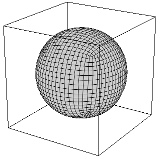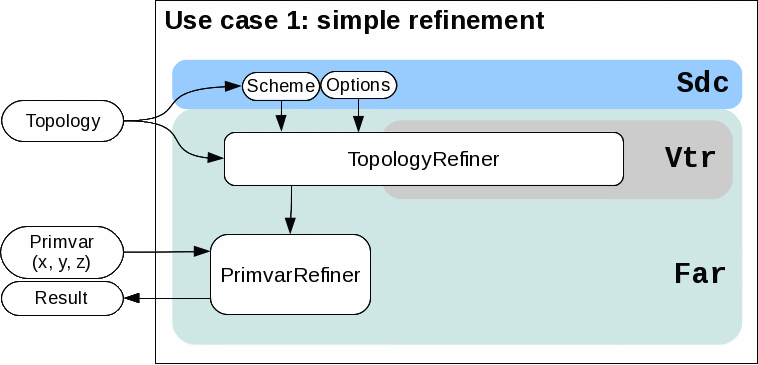API Overview

API Layers
OpenSubdiv is structured as a set of layered libraries. This structure facilitates operation on a variety of computing resources, and allows developers to only opt-in to the layers and feature sets that they require. From a top-down point of view, OpenSubdiv is comprised of several layers, some public, and some private.
Layers list:
| The lowest level layer, implements the core subdivision details to facilitate the generation of consistent results. Most cases will only require the use of simple public types and constants from Sdc. | |
| A suite of classes to provide an intermediate representation of topology that supports efficient refinement. Vtr is intended for internal use only. | |
| The central interface that processes client-supplied geometry and turns it into a serialized data representation ready for parallel processing in Osd. Far also provides a fully-featured single-threaded implementation of subdivision interpolation algorithms. | |
| A suite of classes to provide parameterization, evaluation and tessellation on the CPU. Bfr is more flexible and more scalable than Osd but potentially less efficient. | |
| A suite of classes to provide parallel subdivision kernels and drawing utilities on a variety of platforms such as TBB, CUDA, OpenCL, GLSL and DirectX. |
Client mesh data enters the API through the Far layer. Typically, results will be collected from the Osd layer. However, it is possible to use functionality from Far without introducing any dependency on Osd.
Although there are several entry-points to provide topology and primitive variable data to OpenSubdiv, eventually everything must pass through the private Vtr and Sdc representations for topological analysis.

Using the Right Tools
OpenSubdiv's tiered interface offers a lot flexibility to make your application both fast and robust. Because navigating through the large collection of classes and features can be challenging, here are use cases that should help sketch the broad lines of going about using subdivisions in your application.
General client application requirements:
| Surface Limit | For some applications, a polygonal approximation of the smooth surface is enough. Others require C 2 continuous differentiable bi-cubic patches (ex: deformable displacement mapping, smooth normals and semi-sharp creases...) |
| Deforming Surface | Applications such as off-line image renderers often process a single frame at a time. Others, such as interactive games need to evaluate deforming character surface every frame. Because we can amortize many computations if the topology of the mesh does not change, OpenSubdiv provides 'stencil tables' in order to leverage subdivision refinement into a pre-computation step. |
| Multi-threading | OpenSubdiv also provides dedicated interfaces to leverage parallelism on a wide variety of platforms and API standards, including both CPUs and GPUs. |
| GPU Draw | If the application requires interactive drawing on screen, OpenSubdiv provides several back-end implementations, including D3D11 and OpenGL. These back-ends provide full support for programmable shading. |
Use case 1: Simple refinement
The following example shows the most simple case to get your mesh refined uniformly.


- Define a class for the primvar you want to refine. It's required to have Clear() and AddWithWeight() functions.
struct Vertex { void Clear() { x = y = z = 0; } void AddWithWeight(Vertex const &src, float weight) { x += weight * src.x; y += weight * src.y; z += weight * src.z; } float x, y, z; };
2. Instantiate a Far::TopologyRefiner from the Far::TopologyDescriptor.
Far::TopologyDescriptor desc; desc.numVertices = <the number of vertices> desc.numFaces = <the number of faces> desc.numVertsPerFace = <array of the number of verts per face> desc.vertIndicesPerFace = <array of vert indices> Far::TopologyRefiner * refiner = Far::TopologyRefinerFactory<Descriptor>::Create(desc);
- Call RefineUniform() to refine the topology up to 'maxlevel'.
refiner->RefineUniform(Far::TopologyRefiner::UniformOptions(maxlevel));
4. Interpolate vertex primvar data at 'level' using Far::PrimvarRefiner
Far::PrimvarRefiner primvarRefiner(*refiner); Vertex const *src = <coarse vertices> Vertex *dst = <refined vertices> primvarRefiner.Interpolate(level, src, dst);
- The topology at the refined level can be obtained from Far::TopologyLevel
Far::TopologyLevel const & refLastLevel = refiner->GetLevel(maxlevel); int nverts = refLastLevel.GetNumVertices(); int nfaces = refLastLevel.GetNumFaces(); for (int face = 0; face < nfaces; ++face) { Far::ConstIndexArray fverts = refLastLevel.GetFaceVertices(face); // do something with dst and fverts }
- Done! See Far tutorial 1.1 for the complete code example.
Use case 2: GL adaptive tessellation drawing of animating mesh
The next example is showing how to draw adaptive tessellated patches in GL using OpenSubdiv. The osd layer helps you to interact with GL and other device specific APIs. Also for an efficient refinement of animating mesh on a static topology, we create a stencil table to refine the positions changing over time.
The following example code uses an Osd::GLMesh utility class which composites a stencil table, patch table, vertex buffer and evaluator in osd layer. You can also use those classes independently.

1. Instantiate a Far::TopologyRefiner from the Far::TopologyDescriptor, same as usecase 1.
- Setup Osd::Mesh. In this example we use b-spline endcap.
int numVertexElements = 3; // x, y, z Osd::MeshBitset bits; bits.set(Osd::MeshAdaptive, true); // set adaptive bits.set(Osd::MeshEndCapBSplineBasis, true); // use b-spline basis patch for endcap. Osd::GLMeshInterface *mesh = new Osd::Mesh<Osd::CpuGLVertexBuffer, Far::StencilTable, Osd::CpuEvaluator, Osd::GLPatchTable> (refiner, numVertexElements, 0, level, bits);
3. Update coarse vertices and refine (Osd::Mesh::Refine() calls Osd::CpuEvaluator::EvalStencils())
mesh->UpdateVertexBuffer(&vertex[0], 0, nverts); mesh->Refine();
- Bind index buffer, PatchParamBuffer and vertex buffer
// index buffer glBindBuffer(GL_ELEMENT_ARRAY_BUFFER, mesh->GetPatchTable()->GetPatchIndexBuffer()); // vertex buffer glBindBuffer(GL_ARRAY_BUFFER, mesh->BindVertexBuffer()); glEnableVertexAttribArray(0); glVertexAttribPointer(0, numVertexElements, GL_FLOAT, GL_FALSE, numVertexElements*sizeof(float), 0); // patch param buffer glActiveTexture(GL_TEXTURE0); glBindTexture(GL_TEXTURE_BUFFER, mesh->GetPatchTable()->GetPatchParamTextureBuffer());
- Draw. Since we use b-spline endcaps in this example, there is only one PatchArray in the patch table. You may need to iterate patch arrays as you use other type of endcap. To configure GLSL program for each patch type, see osd shader interface for more details.
Osd::PatchArray const & patch = mesh->GetPatchTable()->GetPatchArrays()[0]; Far::PatchDescriptor desc = patch.GetDescriptor(); int numVertsPerPatch = desc.GetNumControlVertices(); // 16 for B-spline patches glUseProgram(BSplinePatchProgram); glPatchParameteri(GL_PATCH_VERTICES, numVertsPerPatch); glDrawElements(GL_PATCHES, patch.GetNumPatches() * numVertsPerPatch, GL_UNSIGNED_INT, 0);
- As the mesh animates, repeat from step 3 to update positions, refine, and draw. See glViewer and other examples for more complete usage.
